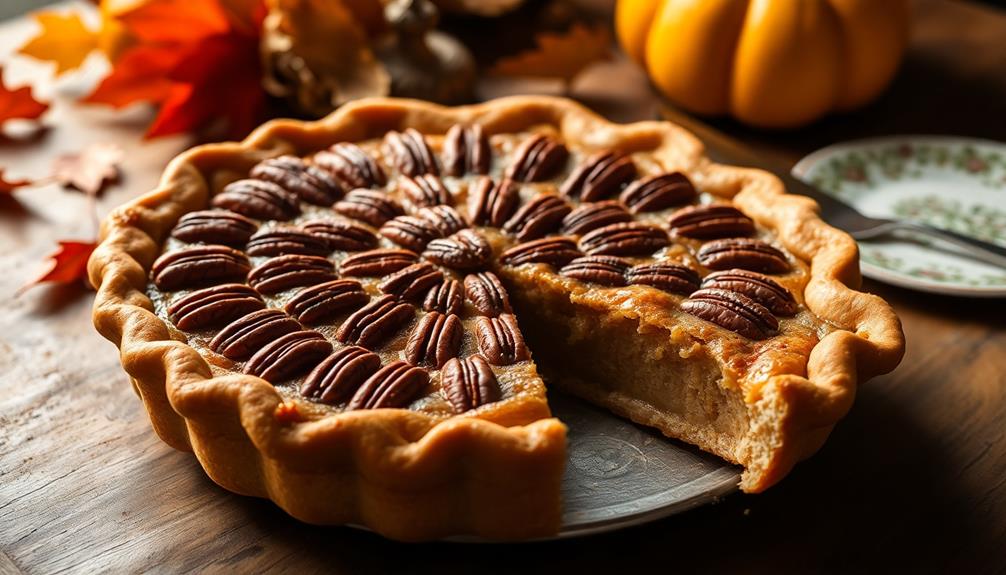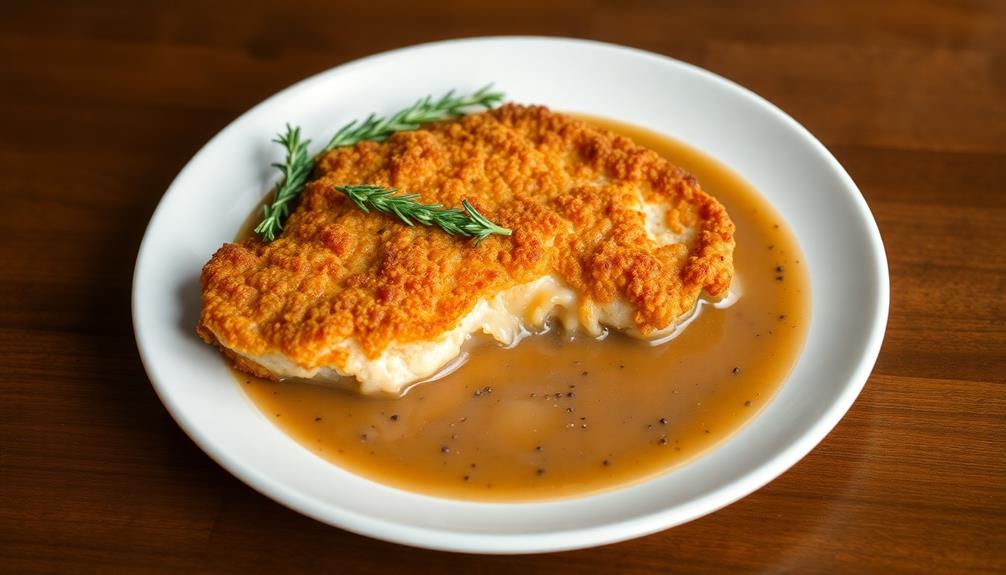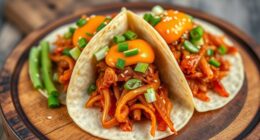Jambalaya is a delicious one-pot dish from Louisiana that you'll love to make and eat! It's a flavorful mix of rice, meat, and veggies that tells a story of different cultures coming together. You can use chicken, sausage, or shrimp, along with the "holy trinity" of onions, celery, and bell peppers. Cooking jambalaya is easy: brown the meats, sauté the veggies, then simmer everything with rice and broth. The result? A comforting meal perfect for family dinners or big gatherings. With its rich history and customizable ingredients, jambalaya offers a taste of Louisiana's culinary heritage that's sure to spark your curiosity.
Key Takeaways
- Jambalaya is a Creole/Cajun rice dish originating from Louisiana, combining meats, vegetables, and spices.
- Key ingredients include rice, chicken, sausage, shrimp, the "holy trinity" (onions, celery, bell peppers), and Cajun seasoning.
- Two main types exist: Creole (with tomatoes) and Cajun (without tomatoes).
- Cooking involves browning meats, sautéing vegetables, and simmering with rice and broth until flavors meld.
- Jambalaya represents a blend of cultural influences, including Spanish, French, and African cuisines.
History
While its exact origins are debated, jambalaya's roots can be traced back to 18th-century Louisiana. You'll find that this dish has a rich history, blending influences from Spanish, French, and African cuisines.
It's believed that jambalaya was created as a way to stretch limited ingredients and feed large groups of people. The name "jambalaya" likely comes from the French word "jambon," meaning ham, and "à la ya," referring to the African word for rice.
As settlers arrived in Louisiana, they brought their cooking traditions with them. They combined these methods with local ingredients to create this hearty, one-pot meal.
You might be surprised to learn that there are two main types of jambalaya: Creole and Cajun. Creole jambalaya, also called "red jambalaya," includes tomatoes and is associated with New Orleans. Cajun jambalaya, or "brown jambalaya," doesn't use tomatoes and is more common in rural areas.
Over time, jambalaya has become a beloved dish throughout Louisiana and beyond. It's now a staple at family gatherings, festivals, and restaurants, showcasing the unique flavors of the region.
Recipe
Jambalaya is a beloved Creole dish that originated in Louisiana, combining influences from Spanish, French, and African cuisines. This one-pot meal is a hearty and flavorful combination of rice, meat, and vegetables, often featuring a mix of chicken, sausage, and shrimp.
This recipe for classic jambalaya is easy to prepare and perfect for feeding a crowd. The key to a great jambalaya lies in building layers of flavor, starting with a base of aromatic vegetables known as the "holy trinity" in Creole cooking: onions, celery, and bell peppers. The dish is then seasoned with a blend of spices that give it its distinctive taste.
- 1 lb boneless, skinless chicken thighs, cut into 1-inch pieces
- 1 lb andouille sausage, sliced
- 1 lb large shrimp, peeled and deveined
- 1 large onion, diced
- 2 celery stalks, diced
- 1 green bell pepper, diced
- 4 cloves garlic, minced
- 2 cups long-grain white rice
- 3 cups chicken broth
- 1 14.5-oz can diced tomatoes
- 2 tbsp Cajun seasoning
- 2 bay leaves
- 2 tbsp vegetable oil
- Salt and pepper to taste
- 1/4 cup chopped fresh parsley
Heat oil in a large, heavy-bottomed pot over medium-high heat. Brown the chicken and sausage, then remove and set aside. In the same pot, sauté the onion, celery, and bell pepper until softened. Add garlic and cook for another minute.
Stir in the rice, broth, tomatoes, Cajun seasoning, and bay leaves. Bring to a boil, then reduce heat and simmer, covered, for 20 minutes. Add the chicken and sausage back to the pot, along with the shrimp. Cook for an additional 5-10 minutes until the shrimp are pink and cooked through.
Remove bay leaves, stir in parsley, and season with salt and pepper to taste. For best results, use a heavy-bottomed pot or Dutch oven to prevent the rice from sticking or burning. Adjust the level of spiciness by increasing or decreasing the amount of Cajun seasoning.
Feel free to customize the protein choices based on your preferences or what you have on hand. Leftover jambalaya can be stored in the refrigerator for up to 3 days and reheated gently on the stovetop or in the microwave.
Cooking Steps
Get ready to cook up a tasty jambalaya!
You'll start by prepping your ingredients and cookware, then sauté the meats and veggies to build flavor.
Next, you'll add rice and let everything simmer, adjusting the seasonings as you go, before serving your delicious creation with a flourish.
Step 1. Prepare Ingredients and Cookware

Before diving into the cooking process, gather all necessary ingredients and equipment.
You'll need a large pot or Dutch oven, a sharp knife, and a wooden spoon. Don't forget measuring cups and spoons!
For ingredients, grab some rice, chicken, sausage, and shrimp. You'll also want onions, bell peppers, celery, and garlic.
Spices are key, so make sure you have paprika, cayenne pepper, thyme, and oregano. Don't forget salt and pepper!
Next, chop your veggies and meat. Dice the onions, bell peppers, and celery. Slice the sausage into bite-sized pieces. Cut the chicken into cubes.
Peel and devein the shrimp if needed.
Measure out your rice and spices. It's easier to have everything ready before you start cooking. Fill a measuring cup with chicken broth, too.
Now, arrange your prepped ingredients near the stove. Place your pot on the burner and grab your wooden spoon.
You're all set to start cooking your delicious jambalaya!
Step 2. Sauté Meats and Vegetables
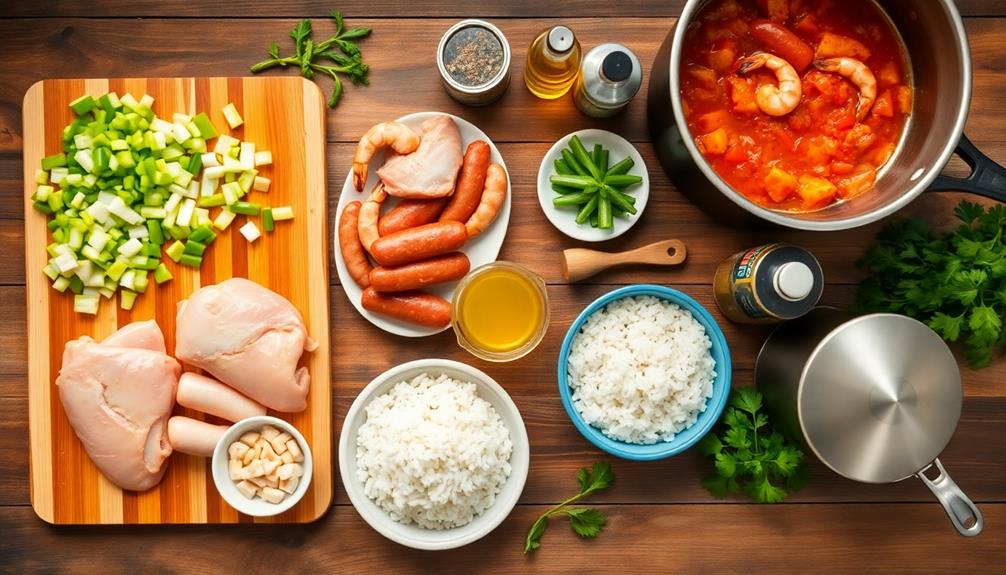
With your ingredients prepped and ready, it's time to fire up the stove and start cooking. Begin by heating a large, heavy-bottomed pot over medium-high heat. Add a splash of oil and let it get nice and hot.
Now, toss in your chopped andouille sausage and chicken pieces. Cook them until they're nicely browned, stirring occasionally. This will take about 5-7 minutes.
Once the meats are cooked, it's time to add your veggies. Throw in the diced onions, bell peppers, and celery. These three ingredients are known as the "holy trinity" in Cajun cooking. Sauté them until they're soft and fragrant, which should take another 5 minutes or so. Don't forget to stir!
Now, add the minced garlic and cook for another minute. You'll smell its amazing aroma filling your kitchen.
At this point, your meats and vegetables are beautifully sautéed and ready for the next step in creating your delicious jambalaya. The flavors are already starting to come together, and you're well on your way to a mouthwatering meal.
Step 3. Add Rice and Simmer

The next crucial step in your jambalaya journey is adding the rice and liquid. It's time to bring all those flavors together!
First, add your uncooked rice to the pot with your sautéed meats and veggies. Stir it well, making sure the rice is coated with all those tasty juices.
Now, it's time for the liquid. You'll want to use a mix of broth and water. Pour it in slowly, giving everything a good stir. The amount of liquid you use depends on how much rice you've added. A good rule is to use about 1 1/2 cups of liquid for every cup of rice.
Once you've added the liquid, bring the pot to a boil. Then, lower the heat and let it simmer. Cover the pot and leave it alone for about 20 minutes.
Don't peek too often! The rice needs time to absorb all that yummy flavor. As it cooks, your kitchen will fill with the most amazing smell. When the rice is tender and the liquid is absorbed, your jambalaya is almost ready to serve!
Step 4. Season and Adjust Flavors
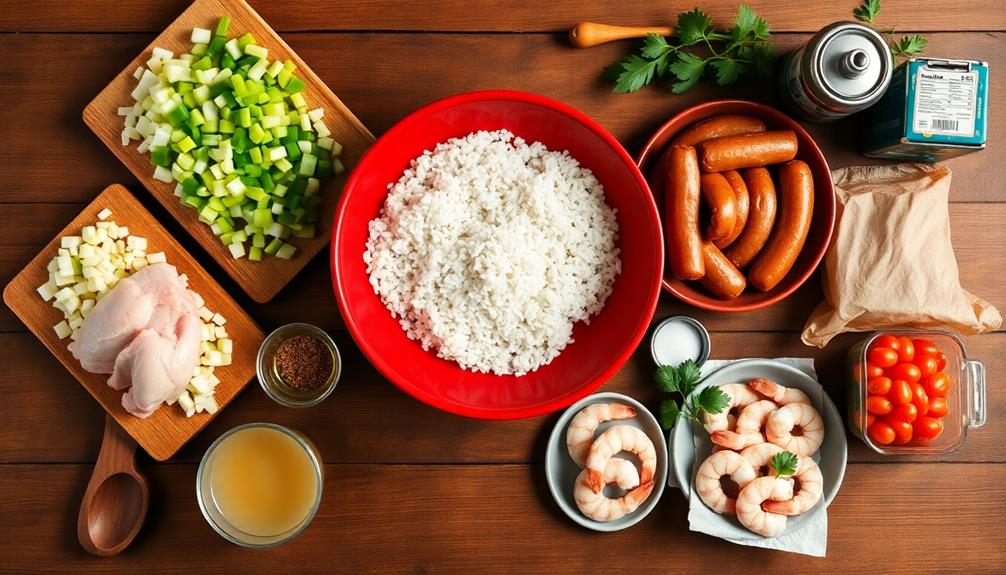
Now that your rice has absorbed all those delicious flavors, it's time to fine-tune your jambalaya. Taste your creation and think about what it needs. Is it spicy enough? Maybe add a dash of hot sauce or cayenne pepper. Does it need more saltiness? Sprinkle in some salt or a splash of soy sauce. If it's too spicy, don't worry! You can balance it out with a squeeze of lemon juice.
Remember, jambalaya is all about bold flavors working together. Stir in some fresh herbs like parsley or green onions for a burst of freshness. You can also add a pat of butter for richness. Keep tasting and adjusting until you're happy with the result. For a traditional Southern touch, consider incorporating some Andouille sausage for a smoky, spicy flavor. If you want to add some extra protein, you can also include some shrimp or chicken. And for a complete meal, serve your jambalaya with a side of cornbread or a classic southern blackeyed pea dish.
As you season, think about the textures too. Is your rice tender? Are the vegetables cooked just right? If needed, let it simmer a bit longer. Your jambalaya should be moist but not soupy. Trust your taste buds and have fun with it!
Soon, you'll have a perfectly seasoned pot of jambalaya that's bursting with flavor.
Step 5. Serve and Garnish Jambalaya

Serving time has arrived for your aromatic jambalaya masterpiece. It's time to showcase your culinary creation and delight your guests with its mouthwatering appearance and scent.
First, give the jambalaya a final stir to ensure all the flavors are well combined. Then, carefully spoon it into a large serving bowl or onto individual plates.
To make your jambalaya even more appealing, add some colorful garnishes. Sprinkle fresh chopped parsley over the top for a pop of green. You can also add thinly sliced green onions for extra flavor and visual appeal. If you like a bit of heat, place a few slices of fresh jalapeño on top.
Don't forget to serve some crusty bread on the side. It's perfect for soaking up the delicious sauce. You might also want to offer hot sauce for those who enjoy an extra kick.
Final Thoughts
In light of its rich history and diverse ingredients, jambalaya stands out as a true culinary masterpiece.
It's a dish that brings people together, combining flavors from different cultures into one delicious pot. When you make jambalaya, you're not just cooking a meal; you're creating a story on a plate.
Remember, there's no one "right" way to make jambalaya. Feel free to experiment with different meats, vegetables, and spices to find your perfect mix.
The beauty of this dish is its flexibility. Don't be afraid to make it your own!
Jambalaya is more than just food; it's a celebration of Louisiana's heritage.
Every time you cook it, you're keeping a tradition alive. It's a great dish for parties, family dinners, or just when you want something comforting and tasty.
Frequently Asked Questions
Can Jambalaya Be Made Vegetarian or Vegan?
Yes, you can make vegetarian or vegan jambalaya. You'll need to swap out traditional meat ingredients for plant-based alternatives like tofu, tempeh, or vegetables. Use veggie broth instead of meat-based stock for a flavorful, meat-free version.
How Long Does Leftover Jambalaya Last in the Refrigerator?
You'll want to store your leftover dish in an airtight container. It'll typically last 3-4 days in the fridge. For best quality, consume it within 2 days. Always reheat thoroughly before eating.
What's the Difference Between Creole and Cajun Jambalaya?
You'll notice Creole jambalaya uses tomatoes, while Cajun doesn't. Creole's also typically made with seafood and has a red color. Cajun's usually brown, made with meat, and has a smokier flavor. They're both delicious Louisiana dishes!
Is Jambalaya Traditionally Spicy, and Can the Heat Level Be Adjusted?
You'll find traditional jambalaya is usually spicy, but don't worry! You can easily adjust the heat level to suit your taste. Just add more or less cayenne pepper and hot sauce when you're cooking.
What Are the Best Side Dishes to Serve With Jambalaya?
You'll want to serve light, refreshing sides that complement the hearty dish. Try a crisp green salad, crusty French bread, or corn on the cob. Don't forget coleslaw or steamed vegetables for a balanced meal.



